[Editor's Note] From July 6-13, 2024, undergraduates of class 2022 from the School of Civil Engineering and Transportation at South China University of Technology (SCUT) participated in an overseas internship and industry exchange program. As a key initiative for international education, the program exposes students to global engineering practices and academic frontiers, aiding their academic/career planning. Notably, this year's program expanded from specialized-reform classes (Civil Engineering Elite English Class, Engineering Mechanics Innovation Class) to all 8 majors, involving 262 students in batch visits to universities, industry organizations, and international consulting firms. Seeing surpasses hearing, practicing surpasses seeing—the school will share students' reflections and outcomes.
This article details a 3-day Hong Kong exchange (July 9-11) by 28 Intelligent Construction majors led by Professor Xiaoyi Lan and Mr. Xi Cui. The activity aimed to broaden students' global perspectives, deepen engagement with the Guangdong-Hong Kong-Macao Greater Bay Area, and explore career development opportunities.
The group visited two universities—Hong Kong University of Science and Technology (HKUST) and Hong Kong Polytechnic University (PolyU)—and three engineering enterprises: Far East Facade, China State Construction (Hong Kong), and Hong Kong Centre for Construction Robotics.
At HKUST on July 9, students engaged with Prof. Yantao Yu (Civil & Environmental Engineering) and two SCUT alumni. Prof. Yu presented departmental admissions and her team’s latest research on worker posture recognition. Students actively questioned and received detailed responses. Alumni shared experiences transitioning from SCUT to HKUST and research insights, inspiring attendees. The group later toured a robotics lab, observing cutting-edge research advancements.

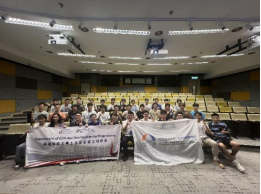
Academic visit at HKUST
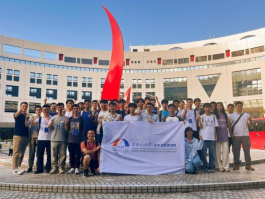

Group photo at HKUST
On the morning of July 10th, the group visited The Hong Kong Polytechnic University (PolyU), located at Hung Hom. PolyU has a long history and significant achievements in the civil engineering field. Dr. Si-Wei Liu from the Department of Civil and Environmental Engineering introduced the department's history and elaborated on recent research from his group. Following this, guided by several professors and senior students from the Department of Building and Real Estate, the group visited labs of various research teams, gaining insights into PolyU teams' research in areas such as VR visualization, intelligent construction equipment, 3D printed concrete, and modular integrated construction (MiC) management. Finally, in PolyU's Civil Engineering Structural Laboratory, the students experienced the advanced experimental facilities and excellent working environment, appreciating the research atmosphere of a top institution.
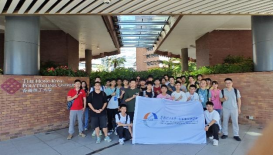
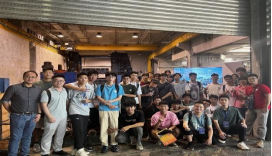
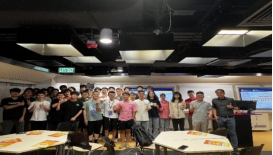
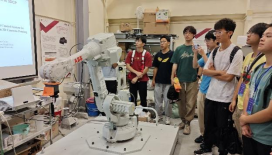
Study group visiting PolyU laboratories
On the afternoon of July 11th, recommended and led by Professor Yaopeng Liu from our School's Department of Civil Engineering, the group visited Far East Facade (Hong Kong) Limited for in-depth learning and exchange. Far East Facade, a subsidiary of China State Construction International Holdings Limited, specializes in facade engineering technology. It has participated in challenging facade constructions such as the Burj Khalifa in Dubai, the OPPO Headquarters, and the 2 Murray Road project in Hong Kong. Far East Facade's Design Director, Chan Sun Neng, and several other company leaders introduced the company's history, notable projects, and applied engineering technologies, deepening the students' understanding of the industry. The entire process of constructing curved facades, the application of BIM in facades, blast-resistant facade design, and more, left a strong impression on the students. They marveled at the intelligent construction technologies showcased in the projects and gained greater confidence in the future development of the industry.
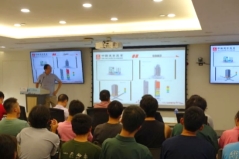
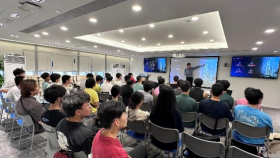
Learning about digital design and integrated construction cases at Far East Facade
To gain a deeper understanding of the intelligent construction industry, on the morning of July 11th, the group visited the Hong Kong Centre for Construction Robotics (HKCRC) located within the Hong Kong Science Park, engaging in discussions with its leaders and engineers about cutting-edge trends in intelligent construction. HKCRC hosts dozens of start-up companies of varying sizes, actively exploring the market application of intelligent construction technologies and management methods. Here, students engaged in in-depth discussions with start-up team leaders, learning about the market demand and development trends for intelligent construction technologies, such as the advantages of these technologies in large-scale building projects accommodating millions of people, and statistics on future employment directions for intelligent construction graduates. Through lively discussions, students found answers and guidance for their questions about the major and uncertainties about future development, such as how to start a business and obtain resources. This visit provided students with a clearer understanding of innovation and entrepreneurship, inspired thinking about personal career planning and development opportunities, and proved highly rewarding.
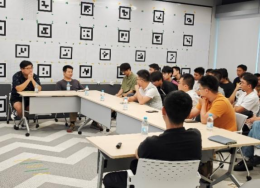
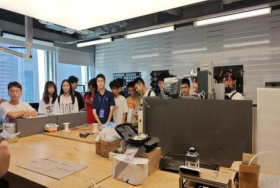
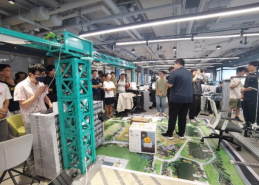
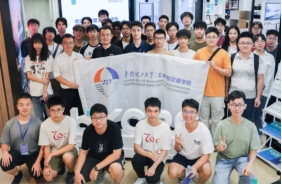
Visiting the Hong Kong Centre for Construction Robotics at Science Park
On the afternoon of July 11th, the group arrived at the exhibition hall of the Haihong R&D Centre of China State Construction Engineering (Hong Kong) Limited. Haihong Technology Company Limited, established in 2014, aims to integrate and apply cutting-edge technologies (like Big Data, AI, Cloud Analytics, IoT, UWB positioning systems) to construction engineering, community, and home management. Haihong developed the C-Smart site management system, which is widely used in construction projects in Hong Kong and Mainland China, effectively addressing industry challenges like site information collection and safety management. Through the explanation, students learned about C-Smart's applicability in the field of smart safety site systems. Its '4S' philosophy (Smart, Site, Safety, System) aligns with ethical requirements in construction and demonstrates vibrant potential. Furthermore, intelligent devices like smart safety helmets recording personal information, smartwatches with heart rate and body fat monitoring, and platforms for monitoring hazardous behaviors on construction sites are driving the industry towards a new era of digitalization in personnel management and safety monitoring. This visit brought the cognitive internship activity to a successful conclusion.
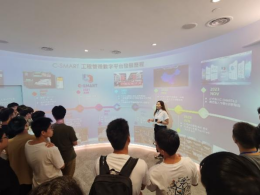
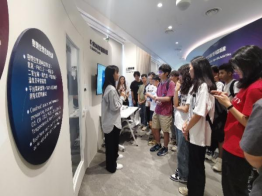
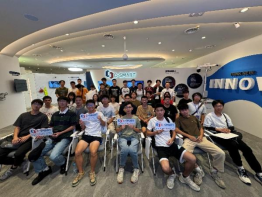
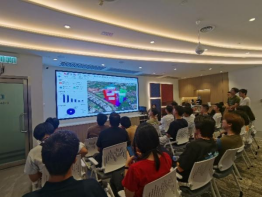
Visiting the C-Smart Haihong Centre at China State Construction (Hong Kong)
During this overseas cognitive internship, students experienced the development potential and vitality of Hong Kong within the Greater Bay Area. They also encountered the world-class academic atmosphere and research strength at the two universities. This opportunity allowed faculty and students to deepen mutual understanding with Hong Kong universities and industry. Looking ahead, against the backdrop of high-quality integrated development in the Guangdong-Hong Kong-Macao Greater Bay Area, it is anticipated that universities in both regions will leverage academic exchange and industrial cooperation to better serve regional economic growth and the development needs of the intelligent construction industry. This cognitive internship not only broadened the students' horizons but also ignited their passion for the field of intelligent construction. This valuable experience will provide beneficial insights for each student's academic and career planning.
Brief Introduction to Visited Universities and Enterprises (in order of visit):
The Hong Kong University of Science and Technology (HKUST): Established in 1991, a member of the Association of East Asian Research Universities (AEARU), dually accredited by AACSB and EQUIS, a member of the Association of Pacific Rim Universities (APRU). An international research university with strengths in business and engineering.
The Hong Kong Polytechnic University (PolyU): Founded in 1937 (originally as the Government Trade School), it is a public applied research university located in Hung Hom Bay, Kowloon, Hong Kong. Officially renamed The Hong Kong Polytechnic University in 1994, it is one of the eight statutory public universities funded by the University Grants Committee 1 (UGC).
Far East Facade (China State Construction International Holdings Limited): Established in Hong Kong in 1969. The Far East Facade brand of China State Construction International Holdings Limited has become a highly competitive specialized company globally and is the oldest, largest, and market-share leading facade company in Hong Kong.
Hong Kong Centre for Construction Robotics (HKCRC): Established in 2020, it is a technology innovation platform jointly established by HKUST and the University of California, Berkeley, under the government's InnoHK initiative. The Centre is dedicated to introducing advanced technologies like robotics, automation, and AI into the construction industry to achieve intelligent construction. It focuses on problem-oriented research with industry support, aiming to realize the industrialization of construction robotics by solving practical problems and leading transformative development in the sector.
Haihong Technology Company Limited: A subsidiary of China State Construction Engineering (Hong Kong) Limited, established in 2014. The company's purpose is to integrate and apply technology (such as Big Data, AI, Cloud Analytics, IoT, UWB positioning systems) to construction engineering, community, and home management. In addition to collaborating with various technology companies, it also conducts its own product research and development.

